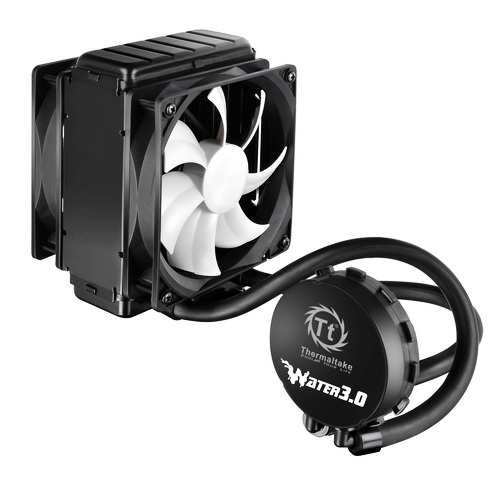INTRODUCTION

Overclockers, enthusiasts and gamers are perhaps the 3 main groups of people who put performance above everything else including money and noise levels so it's really no surprise that their choices include high airflow towers and hardware components with excellent performance yet very high power consumption and noise levels. Not everyone however is a fan of noise and that's why many people either turn towards passive CPU Cooling solutions (for example the HR22) or towards AIO Liquid CPU Coolers that can do a very good job at keeping the CPU Cool without the need of high airflow levels inside the tower. Roughly two years ago Thermaltake released the Water 2.0 line of AIO Liquid CPU Coolers which did a great job competing with the similar solutions released by Antec and Corsair so it was only a matter of time before Thermaltake took that line back to the drawing board and improve it as much as possible. Today we will be taking a look at the Water 3.0 Pro AIO Liquid Cooling Solution which aims to dominate the single 120mm AIO market.
The beginning of every myth and legend is about dreams and desire: the challenging, creative and combative features of Thermaltake Group create an exciting and fascinating user experience to share with everyone, while allowing users to enter a selfless state in terms of function and potential. Thermaltake Group's 3 main brands: Thermaltake, Tt eSPORTS and LUXA2 have been merchandising throughout the world, and have successfully established 6 business footholds in areas such as Europe, America, Oceania, Japan and China, with 95 regional distributors and over 4000 premium retailers. All product planning is orientated by observation of global PC peripheral market and understanding of consumer demands. Thermaltake creates direct contact opportunities with resellers and consumers by participating major global ICT exhibitions and trade shows every year, and develop innovative marketing strategies for the promotions of new products. Meanwhile, Thermaltake incorporates the composite marketing system by making branch offices and regional distributors both the distribution channel and technical support or service center to provide instant support; by maintaining close contact with end users, we manage to strengthen corporate competitiveness and create the momentum for the growth of accomplishments. With its outstanding wisdom and strength Thermaltake Group is recruiting creative talents to build a cultural brand for the enjoyment of entertainment, e-Sports, technology and lifestyle!
The Water 3.0 line of AIO Liquid Cooling Solutions includes three models, the Water 3.0 Performer, the Water 3.0 Pro and the Water 3.0 Extreme. The first model is based on a single 120mm radiator 27mm in thickness paired with two high speed 120mm fans and although it's the mainstream model still we don't see such models with two fans in push and pull which means that it should perform better compared to its immediate rivals. The Water 3.0 Pro is not far off since it too has two 120mm high-speed fans in the bundle but this time over it's based on a single 120mm radiator 49mm in thickness. Finally the Water 3.0 Extreme consists from an 240mm radiator 27mm in thickness paired with two 120mm high-speed fans and although it's probably the best of the three models still not every tower has room for such a solution. Now compared to the previous generation Water 2.0 Pro the new Water 3.0 Pro model features a slightly larger radiator (149.9x119.9x48.8mm/151x120x49mm), slightly faster pump (2800RPM/2900RPM) and two newly designed fans that although spin at the same RPM as their predecessors yet they produce more airflow (81.32CFM/99CFM) with lower noise levels (27.36dBA/20dBA). Unfortunately since the Water 2.0 Pro never reached our hands we can't do a direct comparison between these two models, we can however compare the Water 3.0 Pro with the latest solutions by Antec so let’s see how it compares to them.

 O-Sense
O-Sense









